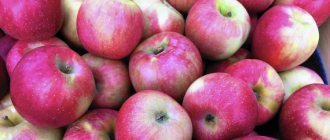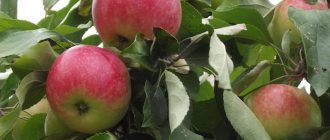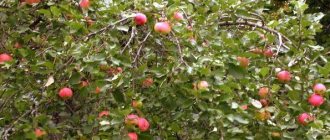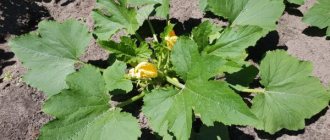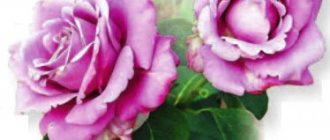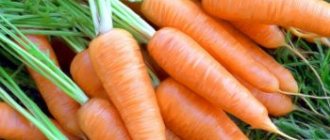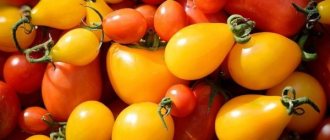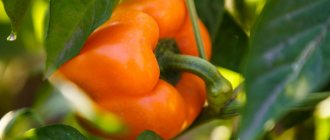It is generally accepted that red color is the only sign of a ripe fruit. However, most often only winter varieties of apple trees can please with this color. Which of the late varieties are the most delicious?
When choosing seedlings of winter, or, as they are also called, late apples , you need to take into account several important factors. Winter apples do not acquire optimal taste immediately after harvesting, but within several weeks or even months after harvesting. In addition, such apple trees have increased winter hardiness and can easily withstand both severe frosts and cold snaps after a thaw.
What are the benefits of late apple varieties?
The main distinguishing feature of late apples is their increased shelf life . They are perfectly preserved until spring (some varieties are stored until summer) and do not lose their original taste and aroma. They are usually harvested at the end of September - beginning of October in the phase of removable maturity. The fruits at this time contain a lot of protopectin and starch . During ripening, the proportion of coloring and aromatic substances in them increases.
Late apples become completely ready for consumption after a few months. Their shelf life, depending on the variety and environmental conditions, ranges from 4 to 8 months.
Advantages of late varieties of apples:
- long shelf life;
- apples ripen and acquire a stable taste and aroma;
- dense consistency and durable peel;
- good transportability;
- Suitable for any type of processing.
Late varieties of apples are also differentiated by shelf life into:
- early winter (Antonovka vulgaris, Pobeditel, Pepin saffron, Parmen winter golden, Welsey) - stored until January-February;
- winter (Scarlet Anise, Gray Anise, Dessert Antonovka, Aport, Cortland, Lobo, Mirnoe, Bergamot Ranet, Northern Sinap, Orlovsky Sinap) - stored until March-April;
- late winter (Mantuan, Sary sinap, Renet Orleans, Renet champagne, Northern sinap, etc.) - stored until May-June.
The main difference between winter varieties of apples and summer ones is that it is not advisable to eat them immediately - they must sit for at least a month.
Winter varieties of apples reviews
Of the later ones, I really like the later Isetskoye.
The apple tree has been growing for a long time. Very tasty apples, stored until spring. The only thing is that there is a frequency of fruiting: one year there are six potato bags, and the next there won’t be even one. pingvinS
There are Imrus and Imant.
This year was the first harvest. Apples are delicious, sweet and sour. I won’t say anything about storage, as long as they are in good condition. Tatyana2012
Legend - very beautiful apples.
They don’t look like Fuji, but an almost exact copy of Red Delicious. A fast-growing and productive variety. I haven't tried it yet. The variety is clearly winter. Kolyadin Roman
After the first frost, the apple season in our orchards ended.
The last apples I collected were the Bratchud variety, which withstood the cold nights and acquired juiciness, sweetness and a pleasant yellowish-white color. This low-growing apple tree produced almost 12 buckets of strong, large and sweet apples this year. Black Label
I really like the Zavetnoye apple tree.
Of the five apple trees that grow in my house, her apples are the most delicious. They do not ripen early, most likely in September, but they can be stored for a long time. The apples are not large, but, I repeat, very tasty. Fruits every year. My top is constantly frozen, so the tree grows wider. Yulka
Pepin Saffron was once considered the best winter variety for central Russia.
In terms of winter hardiness, it belongs to the middle group, along with such old varieties as Babushkino and Skryzhapel. In harsh winters, the trees freeze slightly, but recover well. The tree is below average to medium size. The crown is widely spreading, flat-round, weeping, and of medium density. Flowering later. Vital
I consider Belarusian sweets a valuable variety for their original taste.
In terms of other characteristics, he is also fine. The hand reaches out to this apple. Kolyadin Roman
There is an apple tree as old as the world, the Bogatyr variety.
This is truly a hero - apples weigh up to 750 g, are sweet, and after picking in October they are stored until March. The tree is now about 8 m tall. The variety is winter-hardy. IgaPagan
- Author: Mari
Rate this article:
- 5
- 4
- 3
- 2
- 1
(0 votes, average: 0 out of 5)
Share with your friends!
Idared
Late winter tall variety. The fruits are slightly conical in shape with small blunt or slightly angular ribs. Initially they are green in color, but when exposed to the sun they become covered with a yellow and red blush. The taste is pleasant, with dense and juicy pulp. The variety is resistant to brown spot, but is susceptible to powdery mildew and scab. They are consumed not only fresh, but also used for preparing compotes, dried fruits and juices.
| Entry into fruiting | Tree height (m) | Fruit weight (g) | Harvest | Shelf life (days) | |
| For 5-6 years | 2-3 | 150-190 | End of September | 150-180 | |
Winter apple varieties for the Urals and Siberia
Bratchud
In the State Register since 2001, recommended for cultivation in the Urals. Trees have a maximum height of 2.5–2.7 m, on a dwarf rootstock even less - 1.5–2 m. There is an “innate” immunity to any scab fungus. Fruits are stored for up to 5 months. Average weight is 140–150 g, reaching up to 250 g. The skin is yellow-green, with a faint blush. The pulp is snow-white, medium-juicy, coarse-grained. The fruit is sweet and sour, with a balanced taste. Productivity significantly exceeds the average for the crop.
Zavetnoe
In the State Register since 1995, cultivation in Western and Eastern Siberia is recommended. Grows up to 3 m, compact crown. The fruits are small (within 40 g), slightly flattened. The skin is very pale green, the blush is burgundy, almost solid. The pulp is snow-white, very dense, highly juicy with a bright aroma. The taste is sweet and sour. The harvest is stored all winter. Its volumes are at the standard level.
The Zavetnoye apple tree does not tolerate severe frosts very well, but during the season it quickly recovers
Lada
In the State Register since 1989. Recommended for cultivation in Eastern Siberia. The harvest is stored until early spring. Cold resistance is not a record for Siberia. The variety is early-fruiting (3–4 years), then apples are harvested every season. It resists scab quite well. Grows up to 3.5 m, compact crown. The fruits are small (about 25 g), most often almost round, less often flattened and/or slightly ribbed. The skin is pale yellow, almost its entire surface is covered with a crimson or brick blush. The pulp is snow-white, fine-grained, very dense, medium juicy. The apples taste sweet and sour, the smell is not too obvious.
Lada apples cannot boast of being presentable, but they have a very good taste
Pepin saffron
In the State Register since 1947. The distribution area is very wide - apple trees are recommended to be planted not only in Siberia, but also in all regions west of the Urals. The fruit will last until February. Blooms late, recovers quickly after freezing. Fruiting from the 4th year (from the moment of planting), annual, yield above standard. The dimensions of the apple tree are 3.5–4 m, the crown is wide, “weeping”, and not thickened. The fruits are medium-sized (85 g), sometimes slightly elongated. The skin is yellow-orange, with a solid crimson blush. The flesh is the color of butter, not particularly dense, highly juicy, with a slight pleasant aroma. The fruits are wine-sweet.
Saffron pepin is an almost universal variety.
Antey
A late variety of apples obtained by Belarusian breeders. It has increased frost resistance and can withstand even the harshest winters. The fruits are juicy and sweet and do not lose their aroma for a long time. As they ripen, they change color from green to bright red and burgundy. They often have a waxy coating on them, giving them a bluish tint. Consumer maturity of the fruit occurs 2 months after picking. They can be consumed either fresh or stored for future use.
| Entry into fruiting | Tree height (m) | Fruit weight (g) | Harvest | Shelf life (days) | |
| For 2-3 years | 2-2,5 | 180-200 | Second half of September – early October | 200-240 | |
Where to store apples without refrigeration
After removing the fruits from the tree, there is no need to rush to put them away for long-term storage. You need to leave the apples in a cool place for 2-3 weeks and observe their condition.
Next, the apples need to be re-sorted, placing all the fruits in separate containers in accordance with the variety. If the harvest is large, there are fruits of different sizes; they should also be divided. It should be borne in mind that large fruits will retain their taste slightly longer than small ones. Some gardeners are interested. Do I need to wash fruits before storing them for long-term storage? No, you don’t need to do this, otherwise a significant part of the harvest will be irretrievably lost. Premature deterioration occurs due to damage to the top layer, which provides insulation.
There are several storage methods:
- The fruits are not wrapped in anything; no wrapping material is used. The apples are simply placed in ventilated boxes with the stem facing up. If the stalk is large, it needs to be shortened, otherwise it will damage the fruits located on top. It is impossible to remove it completely, otherwise the fruit will disappear. This method has minimal effectiveness; the owner should carefully inspect the fruits at least once a month. The risk of damage is high.
- The method involves packaging each apple separately. Newspapers or paper towels are used for wrapping, after which the fruits are placed in boxes.
- Apple fruits are often stored in sawdust or sand. These materials also make it possible to increase the shelf life of fruits, but subject to their full compliance with the requirements. The material used must be dry, it is better to heat it in the oven before use to remove infections.
- Apples can be stored in plastic bags. Selected fruits are loaded into 3-4 kg packages and several holes are made in the bag, after which they are hung on hooks in storage.
To extend the storage period, you can use the following methods:
- lubricate the surface of the apple with glycerin or petroleum jelly;
- treat with paraffin, making a wax coating;
- Dip each fruit in an alcohol solution of propolis.
Attention! If the above methods were used, the apple should be thoroughly washed under running water before eating. The same condition must be observed after purchasing fruits in a store, because they are treated with similar compounds in 90% of cases.
For successful storage of crops, it is necessary to ensure the following conditions:
- air humidity – about 90%;
- the room temperature does not fall below -1 and does not rise above +4 degrees;
- The room where apples are stored must be regularly ventilated.
If the above rules are followed, a rich harvest of apples can be preserved for a long time. Estimated time frame: 7 months or more.
Bogatyr
A variety that bears fruit in almost any climate zone. Created as a late winter fruit, the fruits are very hard and strong, under good conditions they can last until the end of May. They have a pleasant sweet and sour taste. Until harvest, the color of the fruit remains light green; while lying in storage, they turn yellow and sometimes become covered with a red blush. The advantages of the variety include early fruiting, resistance to scab, excellent presentation of fruits, transportability, excellent taste and consistently high yield.
| Entry into fruiting | Tree height (m) | Fruit weight (g) | Harvest | Shelf life (days) | |
| For 5-6 years | 2-3 | 150-190 | End of September | 150-180 | |
By strength of growth
Growth vigor is the ability of a tree to grow to a certain height. Most apple trees grow to their stated height in their first years. However, there are species whose plants slowly gain height throughout their lives.
Vigorous
Trees grafted onto a rootstock grown from seeds are considered vigorous. Because of this, without pruning, the trunk can grow up to 6 m in height, and the crown up to 5 m in diameter. Tall apple trees are characterized by a long lifespan (up to 150 years), rich fruiting and drought resistance due to a well-developed root system. Prominent representatives of vigorous apple trees are:
- Gift to the count. Late ripening apple tree with large (300 g) burgundy fruits. The species is resistant to most diseases and pests, and can also preserve the harvest until April.
- Arkadik. Summer ripening apple tree with sweet and sour fruits. The variety is tolerant to scab.
- Cinnamon striped. Early autumn apple variety with excellent frost and drought resistance.
Medium height
Semi-dwarf trees reach a height of up to 3 m and a crown diameter of 2 m. Thanks to their shallow root system (up to 10-40 cm), medium-sized apple trees are sensitive to the fertile characteristics of the soil and require regular watering. Popular semi-dwarf varieties:
- Jonathan. The tree begins to bear fruit in the 5th year and bears fruit at the end of September. Wine-flavored apples can be stored until mid-spring.
- Renet Simirenko. It also begins to bear fruit in the fifth year. The dessert fruits should be harvested in early autumn, then they can be stored until the end of spring.
- Melrose. The annual fruiting of winter apples begins in the 5th year of tree planting. The fruits have a harmonious taste and great weight.
Dwarf apple trees
Trees with a moderate total height of up to 2 m are considered dwarf. Due to their fibrous, weak root system, such apple trees take root well in areas with high groundwater. However, a lack of moisture for seedlings in the first year can be disastrous. Best dwarf trees:
- Wonderful. Late summer, winter-hardy variety, with high disease resistance. Produces large sweet and sour fruits (up to 200 g).
- Down to earth. The plant has a characteristic flattened crown structure with horizontal growth of branches. The high-yielding species produces juicy apples weighing 60-90 g.
- Sokolovskoe. Apple tree with a flattened horizontal crown, winter ripening. Apples have a characteristic red blush and can be stored for up to 3 months.
Jonathan
This late-winter American variety has other names: Winter Red, Winter Khoroshavka, Oslamovskoe. The trees are medium-sized and produce a good harvest only on fertile, sufficiently moist soil. The variety is relatively resistant to powdery mildew and scab. The fruits have excellent taste. By the end of ripening, a red blush covers almost their entire surface.
| Entry into fruiting | Tree height (m) | Fruit weight (g) | Harvest | Shelf life (days) | |
| For 4-5 years | 2,5-3 | 110-150 | Mid September | 150-180 | |
Storage conditions
In order for fruits to last for a long time, you need to know where, in what container, at what temperature and humidity the apples are stored.
Place
Apples in boxes. Photo: Diana Miller
You can store the harvest in the pantry, cellar, basement, balcony and even refrigerator. The main thing is that the conditions for the fruit are optimal.
Tara
Apples are stored well in wooden boxes
The most common containers for winter storage of apples are wooden, cardboard or plastic boxes and various baskets. Remember that good ventilation is needed.
The size of the boxes should not be too large so that the apples do not press on each other with their weight. A small container is also not suitable, since the fruits will be cramped in it.
Metal containers and boxes will not work!
Storage temperature for apples in winter
Storing apples in the cellar
How well the apples will be stored depends on the temperature. Its optimal value is plus four degrees.
Nothing bad will happen if the temperature is a little higher or a little lower.
If we talk about the minimum limit, then the critical values will be the thermometer readings minus one degree.
In your apartment you can store apples in the refrigerator or on the balcony.
The freezing temperature of apples, after which they lose their quality, ranges from minus two to minus four degrees.
Humidity
Use instruments to measure humidity in storage
The most important indicator affecting the long-term preservation of the crop is air humidity.
Its optimal value is 85-90 percent.
To humidify the air, you can place a couple of basins of water next to the boxes.
Lobo
A daughter variety of McIntosh, which inherited from him the best taste and rich red color. The yield of the variety is above average. It bears fruit annually, and the number of apples is constantly growing. It has good winter hardiness and drought resistance. Immunity to diseases is average.
| Entry into fruiting | Tree height (m) | Fruit weight (g) | Harvest | Shelf life (days) | |
| For 4-5 years | 3-4 | 100-180 | From September 25 to October 5 | 150-180 | |
Winter varieties of apples with photos
- Isetskoe later
In the State Register since 1990. In addition to the Volga-Vyatka region, cultivation is possible in the Urals. The fruit will last until March next year. The tree demonstrates good frost resistance, but does not really like hot and dry weather. It resists scab relatively well. Apples are harvested for the first time in the 5th year (counting from planting), then every year, without interruption, the yield is higher than average. The apples are medium-sized (mostly about 75 g, rare specimens up to 120 g). The skin is salad-yellow, practically without blush. The pulp is snow-white, coarse-grained, not juicy, of medium density and aromatic. The fruits are sour-sweet.
- Imrus
In the State Register since 1996. Well suited for the Central and Central Black Earth regions. Is immune to scab of all varieties. The dimensions of the apple tree are 4–5 m, the crown is spherical, not particularly dense. The harvests are stable, every season, in volume - above average. The fruits are strongly flattened, weighing 150–190 g, and will last at least until the end of February. The skin is yellow-green with a soft pink blush. The pulp is crunchy, literally splashes with juice, light creamy, sweet and sour. The taste was rated 4.3 points.
- Winter striped
In the State Register since 1999. A good option for the Middle Volga region. It grows up to 3.5–4.5 m, the crown is compact, almost round. The fruits are small, approximately the same size (88 g). They can be almost spherical or flattened. The skin is golden yellow, covered with fuzzy crimson streaks. The pulp is loose, but juicy, yellowish-cream, almost melts in your mouth. The fruit is sweet and sour (rated 4.5 points). The apple tree is considered to bear fruit quickly (you have to wait only 3–4 years), then it produces a stable harvest every year. Her performance in this regard significantly exceeds the standard.
- Legend
It has been listed in the State Register since 2008, suitable for the Central region. The tree grows actively, reaching its maximum dimensions (4–4.5 m) in 6–7 years. Has a negative attitude towards droughts. Fruits are not one-dimensional (150–300 g). The skin is salad green with spots of pink blush, which “spread” over the apple as it ripens. The flesh is butter-colored, highly juicy, medium-dense. The fruit is first tasted in the 3rd year, the yield is significantly higher than the standard.
Mac
A unique Canadian variety believed to have been bred from the only surviving apple tree in the orchard. The main color of the fruit is whitish-yellow or green, the outer color is presented in the form of purple or dark red stripes. The fruits ripen 2-3 weeks after harvesting. Sometimes, after long-term storage, apples are used for harvesting for future use, but their main purpose is to eat fresh. The taste is moderately sweet and rich. Winter hardiness is average, resistance to scab is low.
| Entry into fruiting | Tree height (m) | Fruit weight (g) | Harvest | Shelf life (days) | |
| 6-7 years | Up to 4 | 150-180 | Second half of September – early October | 150-180 | |
Shelf life and popular varieties
There are many varieties of winter apple trees. However, certain winter-ripening varieties differ in terms of their shelf life. The following winter varieties of apple trees are distinguished:
Early winter. The fruits are stored until approximately January, sometimes until February. These varieties include: Antonovka vulgaris, Pobeditelya, Winter Parmen, Saffron Pepin, and Welsey;
- Winter varieties include: Scarlet Anise, Gray Anise, dessert Antonovka, Orlovsky sinap, Northern sinap, Ranet bergamot, Aport, Lobo, Cortland. These varieties can be stored until March or April;
- Finally, late winter ones are stored until May or even June. These include: Sinap Northern, Renet Champagne and Orleans, as well as Sinap Sarah and Mantuan apple variety.
However, you need to remember that eating late apples is undesirable immediately after picking them.
They need to sit for about a month to ripen. It should also be borne in mind that such varieties are more demanding in terms of self-care. They will need much more heat than the summer varieties. It is also necessary to more carefully care for the soil in which they grow, do not forget to fertilize it, loosen it and water it.
It will be necessary to monitor the formation of the crown - that is, regularly carry out pruning in order to restrain the growth of the tree so that it, as they say, does not go into the branches, but gives all the nutritious juices to the fruits.
Ordinary Antonovka
Among the most common early winter varieties, Antonovka vulgaris is the most popular. This particular apple tree variety is one of the most widespread in the central part of Russia, as well as in Ukraine, Belarus and the Volga region.
Despite the fact that Antonovka was bred in the second half of the last century, it is still in no way inferior to varieties that were bred later. Among the advantages are the following:
- High degree of adaptability to environmental conditions;
- High yield;
- Excellent marketability of fruits;
- Unique aroma and taste;
- Possibility of both eating fresh and processed.
There are, however, also disadvantages. This is a short shelf life, as well as periodicity in fruiting - there can be both fruitful and lean years.
Ukrainian Aport
Aport has been known in Ukraine and Poland since the beginning of the 12th century.
It was brought to Russia by a migrant from Voronezh. Despite the fact that today there are many new winter varieties of apple trees, Aport is not going to leave the race. It is distinguished by its unpretentiousness in growth and the ability to quickly adapt to environmental conditions. In addition, this variety has excellent nutritional qualities and abundant yield.
The ripening period is in September. The fruits are stored well in winter and are large in size.
Belarusian synap
The harvest also occurs in the second half of September. Belarusian sinap is a late-winter variety; there have been cases when it was possible to preserve apple trees until the end of June. However, as a rule, it is possible to preserve the nutritional and other properties of the fruit until May. Which, however, is also not bad.
Among the many undeniable advantages are excellent frost resistance, as well as resistance to scab.
Variety Idared
This winter apple tree belongs to the late winter and tall varieties. The fruits themselves have a slightly conical shape and are often distinguished by characteristic protruding ribs. Collection should begin while they are still green. After lying in the sun for a short time, the fruits begin to turn yellow with a beautiful scarlet blush.
Idared is very pleasant to the taste, it has juicy and dense pulp. It is distinguished, among other things, by good resistance to brown spot, but can easily develop scab or powdery mildew.
It can be eaten not only fresh, but also in compotes, jams, etc. It makes very tasty juices and purees.
Late Antaeus
It was developed in Belarus back in the last century. Antey is distinguished by its excellent resistance not only to cold, but also to rather severe frosts. It has juicy and sweet fruits, which even after a long storage period do not lose their aroma and taste.
During ripening, the color changes from green to burgundy or bright red. You can often notice a waxy coating on apples, which gives them a characteristic bluish tint. You can start eating Antaeus a couple of months after the apples have been picked from the branch. They are also used not only fresh, but also in processing.
Russian hero
A very unpretentious variety that can successfully produce crops in almost any climatic zone. It is characterized by very hard and strong fruits, which can last until May if properly stored.
They taste very pleasant, sweet and sour. Apples remain green almost throughout the entire storage period, only in some cases they can acquire a yellowish tint, occasionally becoming covered with a reddish blush.
The advantages of the variety include, without a doubt, its resistance to scab, as well as early fruiting. Since Bogatyr is distinguished by exceptionally strong fruits, they can be transported over long distances . Productivity is high.
Winter Jonathan
Is American, not domestic. However, sometimes it is called in the Russian manner: Winter Khoroshovka, Oslamovsky, and also Winter Red. The variety is late-winter, that is, it can be stored for a very long time - until summer.
The trees themselves are of medium height, but produce an excellent harvest. Jonathan feels best in moist, fertile soils. It is characterized by good resistance to powdery mildew, as well as scab.
The fruits have a pleasant taste and aroma. Towards the middle of the period, the mats begin to become covered with a red blush, which almost completely covers the entire apple by May.
Apples Mackintosh
We can say that this variety is unique in its own way. It is believed that it was bred from just one surviving apple tree in the entire garden. The fruits are whitish-yellow or green, and may have dark red or purple stripes.
Within a couple of weeks after harvesting, the fruits can be eaten. Sometimes used for making compotes and jams, however, Mackintosh is mainly grown for fresh consumption.
In terms of winter hardiness, Mackintosh belongs to the middle segment. In addition, it does not have very high resistance to scab.
Lobo variety
Lobo is a separate variety of Mackintosh. The best varieties of winter apple trees of this variety were selected so that Lobo could be developed from them. The variety is characterized by high yield and excellent taste . Unlike its “ancestor”, it tolerates cold winters and dry summers well. But disease resistance, although better than that of Mackintosh, is at an average level.
Renet Simirenko
This Russian variety is winter-hardy. It is distinguished by excellent productivity and the ability to withstand drought.
Fruiting begins in the sixth year after planting. The trees are medium in height and quite spreading. The fruits are very large, they have a round shape and are ready for harvesting in early October. Color: light green. The pulp is very tender and tastes sweet and winey, a little spicy.
If you follow all the storage rules, then this variety can be stored until the very beginning of summer without loss of taste and attractive appearance.
Golden Delicious
It also applies to American ones. It is characterized by high yield and is valued for its very sweet taste.
In order for fruiting to begin, pollinators are needed. As a rule, these are apple tree varieties such as Renet Smirenko, Idared or Cortland.
The advantages include excellent transportability of fruits and excellent frost resistance. But Golden is weakly resistant to scab and powdery mildew.
Ripening occurs already in September. Moreover, it is often possible to collect more than 100 kg of fruit from one apple tree. The size of the fruit itself is larger than average. The pulp is a pleasant cream or yellowish shade, it is very juicy and tender. You can store apples until about April.
Sinap Orlovsky
The variety is classified as late winter. The apple trees themselves are quite tall, so you will need to allocate enough space before planting them. The fruits are very large, even in size in comparison with each other.
On the green skin you can notice a reddish blush in places. The taste of the fruit is generally sweet, with a pleasant sourness.
Of course, it is impossible to unequivocally answer the question of what are the best varieties of winter apples offered to gardeners today. Indeed, in this case, you have to take into account a lot of factors. Here are the specific climatic conditions, the nature of the soil, and the storage conditions that the gardener can provide, as well as, of course, his personal preferences. But all the varieties listed above can please you with both their taste and nutritional qualities, as well as their abundant yield if properly cared for.
Red Delicious
The tree is medium-sized; at a young age, the crown looks like an inverted pyramid, and then becomes rounded or broadly rounded. As the fruits ripen, they acquire a bright red rich color. The taste is sweet with a slight iron taste. They store well and withstand transportation. Their only drawback is frequent damage by bitter spot during storage.
| Entry into fruiting | Tree height (m) | Fruit weight (g) | Harvest | Shelf life (days) | |
| For 3-4 years | 3-4 | 200-250 | End of September | 180-210 | |
How are apples processed for long-term storage?
Before storing apples in an apartment, keep them in a cool room for 10-14 days, and then treat them with a special solution.
Before storing for the winter, apples must be carefully checked.
If fruits with defects appear during quarantine, discard them. Sort the rest by variety and size.
It is recommended to make a light pink solution of potassium permanganate and spray the fruits.
You can soak a soft cloth in glycerin and wipe the apples with it.
Another processing option is to dip the apple in a four percent calcium chloride solution for a minute.
Before eating, wash the fruit thoroughly with clean water.
Renet Simirenko
The exact origin of this mixed-bearing winter variety is unknown. The trees usually grow above average in size and are resistant to drought and strong winds. The fruits are medium and large in size. Their main color is light or bright green. A distinctive feature of the variety (and not a disease) is warty formations with a diameter of 7 mm with rustiness on the surface. Their number can reach 2-3 on one fruit. The pulp is white, tender and juicy, with a wine-sweet spicy flavor. The fruits are consumed mainly fresh.
| Entry into fruiting | Tree height (m) | Fruit weight (g) | Harvest | Shelf life (days) | |
| For 4-5 years | Up to 6-7 | 140-170 | Late September – early October | 230-250 | |
Winter varieties of apples in the North-West region:
Druzhnoe
In the State Register for this region since 1987. Apples can be stored until next spring. Frost resistance is not bad, it is immune to scab, and is rarely attacked by harmful insects. The apple tree produces regular and high yields from the 4th–5th year after planting. Grows up to 4 m, the crown is spherical. Fruits are mostly 120 g, less often up to 180 g, rounded-conical, with distinct ribs. The skin is light yellow, about half is covered with pale red blurry spots. The pulp is pale green, fine-grained, extremely dense, highly juicy, almost odorless. The taste is balanced, sweet and sour.
The lack of aroma does not spoil the Druzhnoe variety apples at all.
Belarusian sweet
In the State Register since 2006. Also recommended for the Central region. Apples can be stored until March-April. Grows up to 4–4.5 m, the crown is “weeping”, sparse. The fruit weighs 135–200 g, almost spherical, the ribs are hardly noticeable. The skin is yellowish, almost hidden under a blurry crimson blush. The pulp is snow-white, medium-dense, fine-grained, highly juicy and sweet, almost odorless. The official rating is 4.6 points. Productivity is noticeably higher than standard.
Venyaminovskoe
In the State Register since 2001. A suitable option for planting in the North-Western, Central, Central Black Earth regions, and the North Caucasus. The deadline for storage is the middle of next spring. Not affected by scab. Grows up to 5–7 m, the crown is sparse, spherical. The fruits are approximately the same size, 130 g each. The main yellow-green shade of the skin is almost invisible under the crimson blush. The pulp is coarse-grained, pale green, highly juicy. The taste was rated 4.4 points. Productivity is above standard.
Bogatyr
In the State Register since 1971. In addition to the North-Western, the variety is recognized as suitable for the Central, Volga-Vyatka and Central Black Earth regions. The harvest is stored until the middle of next spring. Fruits resist scab well, leaves are less resistant. The yield is significantly higher than the standard; fruit is harvested annually. The apple tree is tall (5–6 m), the crown is round-cone-shaped, sparse. The fruit is flattened, weighing about 120 g (sometimes up to 200 g). When removed, the salad skin gradually becomes pale yellow, and occasionally a reddish blush appears. The pulp is snow-white, dense, almost without juice, fine-grained, with a pronounced aroma. The taste is sweet and sour, balanced.
A relative disadvantage of the Bogatyr apple tree is low early fruiting, the first fruits are harvested 7–8 years after planting
Jonathan
In the State Register since 1947, recommended for the North Caucasus. A variety from the dessert category. The harvest is stored until May. Winter hardiness is sufficient for the local climate. Does not like drought, is picky about fertilizing and nutritional content of the substrate, and often gets sick. The yield indicators are average, fruiting is annual, the first time - 4-5 years after planting. It grows up to 4–5 m, the crown is “weeping”, spreading, sparse. Fruit weight ranges from 135–165 g. Shape: classic “apple”. Almost the entire golden skin is covered with a pink-red blush. The pulp is the color of butter or pinkish, very dense, highly juicy, fine-grained, with a distinct “apple” smell. The taste is wine-sweet, spicy, officially recognized as “excellent”.
The Jonathan variety was bred in the USA at the very beginning of the 19th century, but still withstands competition from new breeding products
Granie Smith
In the State Register since 2006. Suitable for the North Caucasus. The harvest is stored until May-June. It quickly grows to about 4 m and begins to bear fruit in the 4th–5th year. The crown is in the form of a pyramid, of medium density. The fruits are more or less one-dimensional, symmetrical, weigh 150 g each. The skin is bright green, sometimes with a yellowish-pink blurry blush. The pulp is pale green, homogeneous, crispy. When you bite into the apple, juice literally squirts out. The taste is sweet and sour (4.4 points). Productivity is significantly higher than average. Quite sensitive to drought.
A variety for some reason included in the State Register under the name “Grani Smith”
Ligol
In the State Register since 2021. Cultivation in the Central Black Earth region is recommended. It is not infected with scab, is winter- and drought-resistant, and tolerates heat less well. The dimensions of the apple tree are 6–7 m, it grows at a fast pace. The apples are large (210 g), symmetrical, the ribs are strongly pronounced. The skin is greenish, the blush is dull red. The pulp is coarse-grained, even coarse, dense, highly juicy, light cream. The taste is sweet and sour (4.8 points), the aroma is not very strong. The tree bears fruit every season, and very abundantly.
The taste of Ligol apples received a very high rating from professional tasters - 4.8 points out of five possible
Red Delicious
In the State Register since 2021. Recognized as suitable for landing in the North Caucasus. Apples are considered dessert apples. The tree is resistant to the vagaries of weather (cold, drought, heat), and is extremely rarely infected with powdery mildew. The dimensions of the apple tree are 4–4.5 m, and it reaches them quickly, by 5–6 years. There are no interruptions in fruiting, the yields are high. The crown is round-pyramidal, not particularly dense, compact. The fruit is one-dimensional (195 g), resembling a truncated cone with clear ribs. The skin is greenish-yellow, almost hidden by a dark crimson blush. The pulp is pale green, fine-grained, not too dense, but juicy, with a strong aroma. The taste is sour-sweet (4.7–4.8 points).
Red Delicious apples have one objective drawback - not very good transportability
